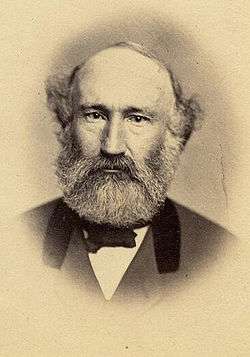William Huntington Russell
| William Huntington Russell | |
|---|---|
 William Huntington Russell, Co-Founder of Skull and Bones, Founder of Collegiate and Commercial Institute, New Haven, Connecticut; Connecticut Legislator (1846-7); Major General, Connecticut National Guard (1862–70) | |
| Born |
August 12, 1809 Middletown, Connecticut |
| Died |
May 19, 1885 (aged 75) New Haven, Connecticut |
| Cause of death | Aneurysm |
| Resting place |
Grove Street Cemetery 41°18′44.532″N 72°55′33.6″W / 41.31237000°N 72.926000°W |
| Nationality | American |
| Alma mater | |
| Occupation |
|
| Known for | Co-founder of Yale secret society Skull & Bones |
| Religion | Protestant Christian (Congregationalist) |
| Spouse(s) | Mary E. Hubbard |
| Children |
|
| Parent(s) |
|
| Relatives | Rev. Noadiah Russell |
William Huntington Russell (12 August 1809 – 19 May 1885) was an American businessman, educator, and politician. He was the founder of the Yale University secret society Skull and Bones.[1]:82 He was a descendant of several old New England families, including those of Pierpont, Hooker, Willett, Bingham, and Russell. His ancestor Rev. Noadiah Russell was a founder and original trustee of Yale College.[2]
Early life
Born in Middletown, Connecticut, Russell was a cadet at the American Literary, Scientific and Military Academy (later Norwich University) from 1826 until graduation in 1828, where he was taught under strict military discipline. In 1828, William's father died, piling family responsibility on to him. Under severe financial restraints, he entered Yale College. He supported himself throughout his college years. In 1823 Samuel Russell, his cousin founded Russell & Co.
Career
Russell had planned on entering the ministry, but his financial problems forced him to obtain an immediate income through teaching. In September 1836, he opened a private prep school for boys in a small dwelling house. The school would become known as the New Haven Collegiate and Commercial Institute. To begin with, the school was only attended by a small number of boys, but by the time of Russell's death the school had become well known and had graduated around 4,000 boys. In about 1840, Russell introduced a very thorough military drill and discipline into his school. He foresaw a Civil War in the future, and wanted to make sure his boys were prepared to fight for the Union. His students were so well schooled in military affairs that on the outbreak of Civil War some were enlisted as drill instructors.
He not only gave his students to the Union army, but also his own services. Governor William Alfred Buckingham realized that Russell was one of the most knowledgeable men in military affairs. For this reason, Russell was hired to organize the Connecticut militia. He was later made a major-general by act of the legislature.
From 1846 to 1847, Russell served as a Whig in the Connecticut state legislature. Upon the repeal of the Missouri Compromise in 1854, he became active as one of the leaders of the movement which resulted in the organization of the Republican Party. He was a strong abolitionist and a friend of John Brown. Russell was named as a trustee in the will of John Brown. He was also the Connecticut representative on the National Kansas Committee.
Later life
In 1856, with several other Bonesmen, he incorporated Skull and Bones as the Russell Trust, later the Russell Trust Association. The Russell Trust Association is a tax-exempt association; it holds possession of the Skull and Bones Hall at Yale University and the society's holiday island, Deer Island.
Death
In May 1885, Russell saw some boys throwing stones at birds in the park in New Haven, Connecticut. Russell sought to protect the birds from the boys. The activity was too much for him and he fell unconscious from a fatal rupture of a blood vessel and died several days later.[3]
References
- ↑ Robbins, Alexandra (2002). Secrets of the Tomb: Skull and Bones, the Ivy League, and the Hidden Paths of Power. Boston: Little, Brown. ISBN 0-316-72091-7.
- ↑ William Richard Cutter (1913). New England Families, Genealogical and Memorial, Vol. 3. New York: Lewis Historical Publishing Company. Retrieved 14 August 2010.
- ↑ Osborn, Norris Galpin (1904). Men of mark in Connecticut: ideals of American life told in biographies and autobiographies of eminent living Americans, Volume 2. W.R. Goodspeed. pp. 410–423.
- Whitlock, Reverdy. "William Huntington Russell and the Collegiate and Commercial Institute," Journal of the New Haven Colony Historical Society 18, no. 4 (December 1969): 83–89.
External links
"William Huntington Russell". Patriot & Teacher. Find a Grave. May 11, 2006. Retrieved August 11, 2012.